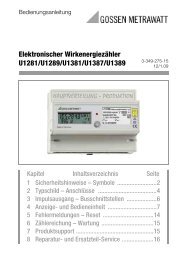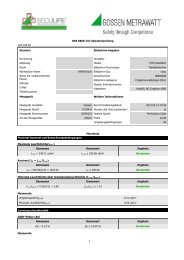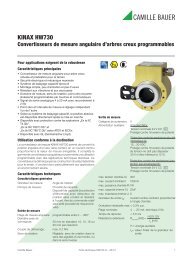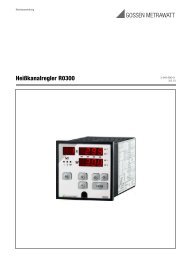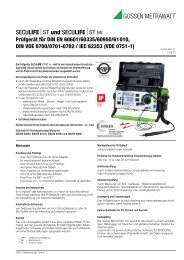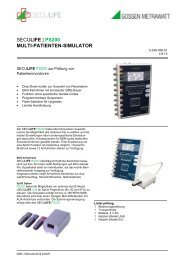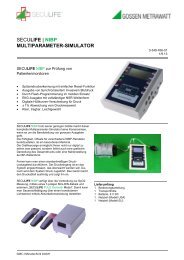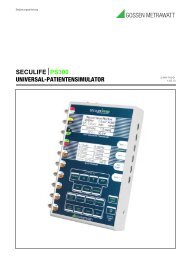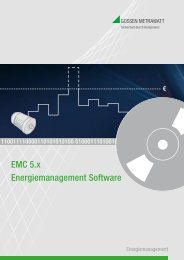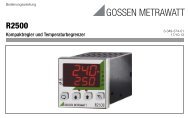M-Bus Communication Protocol - Gossen-Metrawatt
M-Bus Communication Protocol - Gossen-Metrawatt
M-Bus Communication Protocol - Gossen-Metrawatt
You also want an ePaper? Increase the reach of your titles
YUMPU automatically turns print PDFs into web optimized ePapers that Google loves.
2.1.1 C Field<br />
The Control Field (C Field) contains information on the direction of the exchange of communication, the success of the actual<br />
operation of communication and the proper function of the telegram.<br />
English<br />
Bit Number 7 6 5 4 3 2 1 0<br />
Master > Slave 0 1 FCB FCV F3 F2 F1 F0<br />
Slave > Master 0 0 ACD DFC F3 F2 F1 F0<br />
Table 2.2 – C Field Bit Division<br />
The Bit Nr 6 is set to 1 if the communication has the direction Master > Slave; viceversa it is set to 0.<br />
In the Master > Slave direction, if the frame count bit valid (FCV - Bit Nr 4) is set to 1, then the frame count bit (FCB – Bit Nr 5) has<br />
not to be ignored.<br />
The FCB is used to indicate successful transmission procedure. A Master shall toggle the bit after a successful reception of a reply<br />
from the Slave. After this, if the Slave answer is multi-telegram, the Slave has to send the next telegram of the multi-telegram<br />
answer.<br />
If the expected reply is missing, or the reception faults, the master resends the same telegram with the same FCB.<br />
The Bits Nr 3 – 0 are the function code of the message.<br />
The C Field used here, are:<br />
Telegram Name C Field (BIN) C Field (HEX) Telegram Description<br />
SND_NKE 01000000 40 Short Frame Initialization of the Slave<br />
SND_UD 01x10011 53 / 73 Long Frame Master send data to Slave<br />
REQ_UD2 01x11011 5B / 7B Short Frame Master requests Class 2 Data to Slave<br />
RSP_UD 000x1000 08 / 18 Long Frame Data transfer from Slave to Master<br />
Table 2.3 – C Field of the commands used in this protocol<br />
2.1.2 A Field<br />
The Address Field (A Field) is used to address the recipient in the calling direction, and to identify the sender of information in the<br />
receiving direction.<br />
The size of this field is one byte, and it can assume the value between 0 – 255, divided in this way:<br />
A Field (HEX) Primary Address Remarks<br />
00 0 Default Address Given by Manufacturer<br />
01 – FA 1 – 250 Primary Address Settable<br />
FB, FC 251, 252 Reserved for Future Use<br />
FD 253 Used for Secondary Address Procedures<br />
FE 254 Use to Transmit Information to All Partecipants in the M-BUS System<br />
FF 255 Use to Transmit Information to All Partecipants in the M-BUS System<br />
Table 2.4 – Value of Address Field<br />
Using the address 254 (FEh) every Slave answer with the acknowledging (E5h) or with their primary address.<br />
Using the address 255 (FFh) no one Slave replies.<br />
2.1.3 CI Field<br />
The Control Information (CI Field) contains information for the receiver of the telegram.<br />
The CI Field values used here, are:<br />
CI Field (HEX)<br />
Primary Address<br />
51 The telegram contains data for the Slave<br />
52 Selection of the Slave<br />
72 The telegram contains data for the Master<br />
B8<br />
B9<br />
Set Baud Rate to 300 bps<br />
Set Baud Rate to 600 bps<br />
10 M-<strong>Bus</strong> communication protocol




